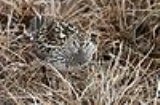
White-rumped Sandpiper
Encyclopedia
The White-rumped Sandpiper (Calidris fuscicollis) is a small shorebird.
Adults have black legs and a small thin dark bill. The body is dark brown on top and mainly white underneath, with brown streaks on the breast and a white rump. They have a white stripe over their eyes. This bird shows long wings in flight. In winter plumage
, this species is pale gray above. This bird can be difficult to distinguish from other similar tiny shorebirds; these are known collectively as "peeps" or "stint
s".
One of the best identification features is the long wings, which extend beyond the tail when the bird is on the ground. Only the Baird's Sandpiper
also shows this, and that bird can be distinguished by the lack of a white rump.
Their breeding habitat is the northern tundra on Arctic islands in Canada and Alaska. They nest on the ground, usually well-concealed in vegetation.
They are a long distance migrant
, wintering in northern South America. They are rare but regular vagrants to western Europe. The species is a rare vagrant to Australia.
These birds forage by probing on mudflats or tundra or picking up food by sight in shallow water. They mainly eat insects, mollusks and marine worms, also some plant material.
Hybrids between this species and the Dunlin
are occasionally found in northeastern North America (McLaughlin & Wormington, 2000, and external link below); the White-rumped Sandpiper is also suspected to hybridize with the Buff-breasted Sandpiper
.
Adults have black legs and a small thin dark bill. The body is dark brown on top and mainly white underneath, with brown streaks on the breast and a white rump. They have a white stripe over their eyes. This bird shows long wings in flight. In winter plumage
Plumage
Plumage refers both to the layer of feathers that cover a bird and the pattern, colour, and arrangement of those feathers. The pattern and colours of plumage vary between species and subspecies and can also vary between different age classes, sexes, and season. Within species there can also be a...
, this species is pale gray above. This bird can be difficult to distinguish from other similar tiny shorebirds; these are known collectively as "peeps" or "stint
Stint
A stint is one of several very small waders in the paraphyletic "Calidris" assemblage - often separated in Erolia -, which in North America are known as peeps...
s".
One of the best identification features is the long wings, which extend beyond the tail when the bird is on the ground. Only the Baird's Sandpiper
Baird's Sandpiper
The Baird's Sandpiper is a small shorebird. It is among those calidrids sometimes separated in Erolia.Adults have black legs and a short thin dark bill. They are dark brown on top and mainly white underneath with a black patch on the rump. The head and breast are light brown with dark streaks. In...
also shows this, and that bird can be distinguished by the lack of a white rump.
Their breeding habitat is the northern tundra on Arctic islands in Canada and Alaska. They nest on the ground, usually well-concealed in vegetation.
They are a long distance migrant
Bird migration
Bird migration is the regular seasonal journey undertaken by many species of birds. Bird movements include those made in response to changes in food availability, habitat or weather. Sometimes, journeys are not termed "true migration" because they are irregular or in only one direction...
, wintering in northern South America. They are rare but regular vagrants to western Europe. The species is a rare vagrant to Australia.
These birds forage by probing on mudflats or tundra or picking up food by sight in shallow water. They mainly eat insects, mollusks and marine worms, also some plant material.
Hybrids between this species and the Dunlin
Dunlin
The Dunlin, Calidris alpina, is a small wader, sometimes separated with the other "stints" in Erolia. It is a circumpolar breeder in Arctic or subarctic regions. Birds that breed in northern Europe and Asia are long-distance migrants, wintering south to Africa, southeast Asia and the Middle East...
are occasionally found in northeastern North America (McLaughlin & Wormington, 2000, and external link below); the White-rumped Sandpiper is also suspected to hybridize with the Buff-breasted Sandpiper
Buff-breasted Sandpiper
The Buff-breasted Sandpiper, Tryngites subruficollis, is a small shorebird. It is a calidrid sandpipers and currently considered to be the only member of the genus Tryngites. Indeed, it probably belongs in the genus Calidris itself, or more precisely with the small species thereof which should be...
.
External links
- Ocean Wanderers: A putative hybrid White-rumped Sandpiper × Dunlin from the east coast of the USA. Retrieved 2006-Oct-11
- An online identification article covering this species and other small calidrids
- White-rumped Sandpiper Species Account - Cornell Lab of Ornithology
- White-rumped Sandpiper - Calidris fuscicollis - USGS Patuxent Bird Identification InfoCenter
- White-rumped Sandpiper Information - South Dakota Birds and Birding

